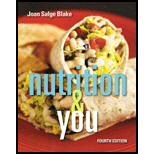
Nutrition & You (4th Edition)
4th Edition
ISBN: 9780134167541
Author: Joan Salge Blake
Publisher: PEARSON
expand_more
expand_more
format_list_bulleted
Question
Chapter 6, Problem 6.9CYU
Summary Introduction
Introduction: Proteins are made up of the amino acids. Messenger-ribonucleic acid (mRNA) is converted into protein through the process of translation. Proteins form the structure and support the cells. They are coded by genes and form the basis of all living organisms. Some proteins that catalyze the biological reactions are as called enzymes that
Expert Solution & Answer
Want to see the full answer?
Check out a sample textbook solution
Chapter 6 Solutions
Nutrition & You (4th Edition)
Knowledge Booster
Similar questions
- The word DETERMINE is an acronym used in assessing an elderly person's.. a. risk of malnutrition b. bone integrity c. degree of independence d. all of the abovearrow_forwardWhich of the following preventative measures should a pregnant woman take to avoid contracting listeriosis? a. avoid feta cheese b. avoid pasteurized milk c. thoroughly heat hot dogs d. a and carrow_forward
Recommended textbooks for you
 Nutrition: Concepts and Controversies - Standalo...Health & NutritionISBN:9781305627994Author:Frances Sizer, Ellie WhitneyPublisher:Brooks Cole
Nutrition: Concepts and Controversies - Standalo...Health & NutritionISBN:9781305627994Author:Frances Sizer, Ellie WhitneyPublisher:Brooks Cole NutritionHealth & NutritionISBN:9781337906371Author:Sizer, Frances Sienkiewicz., WHITNEY, ElliePublisher:Cengage Learning,Essentials Health Info Management Principles/Prac...Health & NutritionISBN:9780357191651Author:BowiePublisher:Cengage
NutritionHealth & NutritionISBN:9781337906371Author:Sizer, Frances Sienkiewicz., WHITNEY, ElliePublisher:Cengage Learning,Essentials Health Info Management Principles/Prac...Health & NutritionISBN:9780357191651Author:BowiePublisher:Cengage

Nutrition: Concepts and Controversies - Standalo...
Health & Nutrition
ISBN:9781305627994
Author:Frances Sizer, Ellie Whitney
Publisher:Brooks Cole

Nutrition
Health & Nutrition
ISBN:9781337906371
Author:Sizer, Frances Sienkiewicz., WHITNEY, Ellie
Publisher:Cengage Learning,

Essentials Health Info Management Principles/Prac...
Health & Nutrition
ISBN:9780357191651
Author:Bowie
Publisher:Cengage